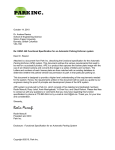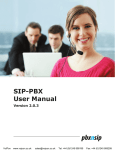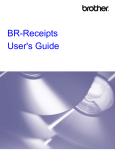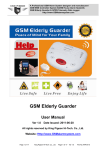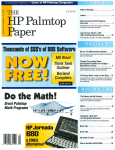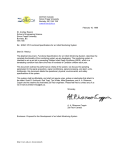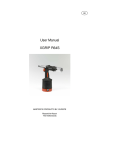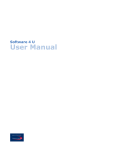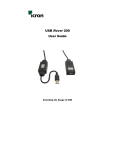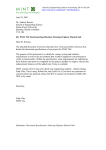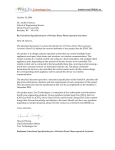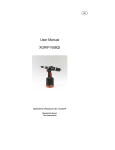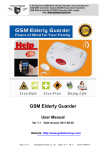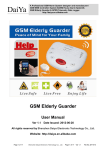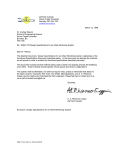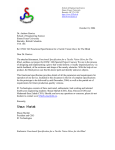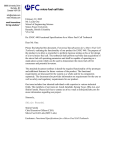Download Rodin Maroufi - School of Engineering Science
Transcript
December 17, 2010 Dr. Andrew Rawicz School of Engineering Science Simon Fraser University Burnaby, British Columbia V5A 1S6 Re: ENSC 440 Post Mortem for an Automatic Parking Enforcer system Dear Dr. Rawicz: Please find the post mortem for an Automatic Parking Enforcer (APE) system attached to this document. The APE system is an automatic license plate registration system, designed to ease and aid in the patrolling of large parking lots such as SFU Burnaby. The system is composed mainly of software components, such as: a GUI, an Image Processing Unit, and a database. The hardware component of the system consists of an Infrared Camera. In this post mortem, the following topics will be discussed: the current state of the APE system, digressions from the functional specs, future improvements which will be implemented on the APE system, comparison between the theoretical and actual budget, and personal experience of all the Park Inc. team members. The APE system is produced by Park Inc. Which consists of five talented and dedicated members: Rodin Maroufi, Rosy Johal, Amin Moshgabadi, Yi-Chen Kuo, and Shadi Rohani. Please feel free to contact us with any questions or comments that you may have regarding this post mortem by phone at 778.865.2444 or by e-mail at [email protected]. Thank you, for your interest in our product. Sincerely, Rodin Maroufi Rodin Maroufi President and CEO Park Inc. Enclosure: Post Mortem for an Automatic Parking System Copyright ©2010, Park Inc. Post Mortem for an Automatic Parking Enforcer System Project Team: Rodin Maroufi Rosy Johal Amin Moshgabadi Yi Chen Kuo Shadi Rohani Contact Person: Rodin Maroufi rma12 @sfu.ca Submitted to: Dr. Andrew Rawicz Michael Sjoerdsma School of Engineering Science Simon Fraser University Issued Date: December 17, 2010 Revision: 1 Copyright ©2010, Park Inc. Table of Contents Glossary........................................................................................................................................................ iii 1. Introduction .......................................................................................................................................... 1 1.1 Scope....................................................................................................................................... 1 1.2 Intended Audience .................................................................................................................. 1 2. Current State of the System.................................................................................................................. 2 3. Digressions from the Functional Specifications....................................................................................5 3.1 General Requirements ..............................................................................................................5 3.2 Mechanical Requirements......................................................................................................... 5 3.3 LPR Software Requirements...................................................................................................... 5 3.4 Performance Requirements ...................................................................................................... 5 3.5 User Manual Requirements....................................................................................................... 6 3.6 Reliability and Durability ........................................................................................................... 6 3.7 Safety Requirements ................................................................................................................. 6 4. Future Work ......................................................................................................................................... 6 5. Budget ................................................................................................................................................... 7 5. Timeline................................................................................................................................................. 8 6. Personal Reflections.............................................................................................................................. 9 6.1 Rodin Maroufi – Bozorgi (CEO) ................................................................................................. 9 6.2 Rosy Johal (COO) .....................................................................................................................10 6.2 Amin Moshgabadi (CTO) .........................................................................................................10 6.2 Yi Chen Kuo (CFO)....................................................................................................................10 6.2 Shadi Rohanivedghi (CMO) ..................................................................................................... 10 7. Conclusion...........................................................................................................................................12 8. References ..........................................................................................................................................13 Copyright ©2010, Park Inc. ii List of Figures Figure 1: High Level Diagram of the APE System.........................................................................1 Figure 2: Overview of the APE System.........................................................................................2 Figure 3: High Level Block Diagram of the License Plate Unit......................................................3 Figure 4: High Level Block Diagram of the GUI.............................................................................4 Figure 5: Main Window of the APE System...................................................................................4 Figure 6: Intial Schedule for the APE System...............................................................................8 Figure 7: Actual Timeline for the APE System..............................................................................8 List of Tables Table 1: Initial Budget of the APE System.....................................................................................7 Table 2: Actual Budget of the APE System...................................................................................7 Glossary APE Automatic Parking Enforcer CSA Canadian Standards Association GUI Graphical User Interface LPR License Plate Registration PFSA Parking Federation Standard Association SSL Secure Socket Layer Copyright ©2010, Park Inc. iii 1. Introduction Park Inc. was created in September 2010, the Park Inc. team consists of two Systems Engineering and three Electronics Engineering fourth year SFU students. In the middle of September, Park Inc. introduced the APE system to ease in patrolling large parking lots. The APE system is an automated license plate registration system. The back bone of the APE system is an infrared camera, and a software program with a graphical user interface. The infrared Camera is mounted on a patrolling officer’s vehicle and is responsible for retrieving a clear image of a parked vehicle. The image processing component of the software is responsible for recognizing the license plate from the image, segmenting the license plate from the entire image of the vehicle, and recognizing all the characters on the license plate in order to compare with a database. The other components of the software include a database and a GUI. The database contains the license plate numbers of the vehicles which have a proper parking permit. The GUI compares the license number obtained from the vehicle to the database and shows the result of this computation in a user friendly environment. Figure 1 , shows how all the components in the APE system will interact. Figure 1: High Level Block Diagram of the APE System [2] In accordance, with an existing SFU parking policy, our product allows the driver to register more than one license plate number under their permit. However, in order to prevent drivers from abusing the system, our product will not let two or more vehicle under one permit be parked in the parking lot simultaneously. 1.1 Scope This document will cover the following topics: the current state of the APE system, digressions from the functional specifications, future work, comparison between the actual and theoretical budget and time line for the APE system, and finally personal reflections by all the Park Inc. team. 1.2 Intended Audience The intended audience of this document are the Professors and TAs responsible for marking ENSC 440 and ENSC 305. The purpose of this document is to provide enough information to the audience mentioned above to determine the success of our project. 1 2. Current State of the System Park Inc. has built the prototype which was described in the project proposal. Currently, the APE system works in the following manner: an infrared camera captures video from a vehicle, this video is then converted into many snapshots, the clearest of these images is converted to greyscale and is passed through an image processing unit, the output of the image processing unit is then passed to the OCR to read the characters, the characters on the license plate is then compared to the license plate numbers in the database, the result of that comparison is displayed on the GUI. Figure 2 shows the overview of the APE system. Figure 2: Overview of the APE System [1] The APE system is currently implemented by using a infrared camera with a 30 frames per second rate, and 42 led lights. This camera can operate in the temperature range of -30 to 45 Celsius, which would enable it to operate year round in Vancouver. The camera also has a cover which shields it from extremities such as rain and snow. Furthermore, the camera meets all the functional requirements set in the functional specification document. 2 The software component of the APE system consists of: a license plate recognization unit , a license plate segmentation unit, an OCR, a database, and a GUI. The letter recognization unit uses the OPenCV library to perform matrix manipulation on the image, and the final step in the this component of the APE system is to perform morphological edge detection to determine the location of the license plate from the whole image. Figure 3 shows the high level block diagram of the License Plate Recognization unit. Figure 3: The High Level Block Diagram of the License Plate Unit [3] Currently, the letter recognization unit successfully recognizes the license plate from a image of the whole vehicle with a success rate of 95 percent. Thus, the license plate recognization unit is deemed a success because it meets the functional specifications. The next step in the image processing process is the license plate segmentation unit. The license plate segmentation unit crops the license plate from the whole image once it has been recognized. At the moment, the license plate segmentation unit has a success rate of 70 percent. This is because the Skew Correction algorithm was not used in our license plate segmentation unit due to time restraints. The Skew Correction algorithm aligns the image properly in order to allow the OCR to recognize the characters properly. The next step in the image processing process is the OCR unit. For the OCR unit an open source software (Tesseract) was used to recognize the characters on the license plate. Currently, the OCR has a success rate of 95 percent. Thus, the OCR is deemed successful. The next step is to compare the output of the OCR with a MySQL database that has all the license plate information of valid parking permit holders. At the moment, the database allows more than one vehicle to be registered under one name and it will not allow more than one license plate registered under the same permit to be present in the parking lot simultaneously. Furthermore, the database can be expanded and updated in real time and it has a success rate of 100 percent. Thus, the database is considered very successful. 3 The next step in the APE system is to output the result of the comparison from the database in a user friendly environment. The high level block diagram of the GUI is shown in Figure 4. The GUI contains a Login Window in order to restrict those without permission gaining access to the APE system. Once, the patrol officer has logged in properly, they will be sent to the next window containing a map of SFU Burnaby parking lots. This is required because currently SFU has a different prices for different parking lots and the Park Inc. team wanted to honour this system in the APE product. Figure 4: The High Level Block Diagram of the GUI [3] Once a parking lot has been selected the Main Window will appear. Figure 5 shows the design of the Main Window. The Main Window contains: a video component, a camera component, a read component, a search option, a database component, a validation check, a go back to SFU map button and a log off button. The video component shows the output of the Infrared Camera, the camera component shows the picture of the license plate once it has been segmented from the whole image, the read component shows the characters which have been read by the OCR. The search option allows one to manually search for a license plate if for some reason the program doesn’t read the license plate. The validation check shows if the license plate belongs to a vehicle with a valid permit. The “Go Back to SFU Map” button allows the user to switch to another parking lot. When they have finished monitoring the parking lot they are currently in. The “Log Off” button allows the user to exit the program. Overall, the system is around 70 percent success rate. This is attributed to not using the Skew Correction algorithm. Figure 5: Main Window of the APE System [3] 4 3. Digressions From the Functional Specifications As mentioned above the current APE system has a success rate of 70 percent due to not implementing the Skew Correction algorithm in the license plate segmentation unit. Thus, in this section the digressions from the functional specifications will be discussed. However, the following sections in the functional specifications have had all their requirements met: physical requirements, environmental requirements, electrical requirements, usability and standards requirements. 3.1 General Requirements Currently, the APE system meets all the general requirements. The speed of the security vehicle carrying the infrared camera is much slower than 30 km/hour, the infrared camera can operate in rain, fog, and snow, the final product would be sold for about $1900 Canadian, and the APE system will let the patrol officer choose a parking lot to patrol. However, one digression from the functional specs is that software will work for all North American License plates rather than just BC license plates. This discrepancy arose due to miscommunication when writing the functional specifications because the APE system was always designed to work with all the license plates in North America. 3.2 Mechanical Requirements The mechanical requirement of not having a locking mechanism to prevent the theft of the infrared camera was not achieved in the final design of the APE system. The Park Inc. team could not find a camera bracket with such a feature in the price range of a hundred dollars. 3.3 LPR Software Requirements Currently, the APE system does not meet all the LPR software requirements. The software does not correctly localize and segment the license plate with only marginal error because of not using the Skew Correction algorithm. However, the OCR does function properly 95 percent of the time and the processing power of the APE system fast enough not to miss any vehicles. 3.4 Performance Requirements APE system has met all but one performance requirement. The image taken by the camera does have noise which was not all cancelled. However, the laptop does compare the license plate number to the database in real time, the whole process completes in less than a second, and the infrared camera can accommodate fast moving vehicles. 5 3.5 User Manual Requirements At the moment, the APE system does not contain a user manual. Operating the APE system is quite easy and intuitive. However, a manual for installation is also not included, which could lead to some complexities. Additionally, no website or email address have been established in order to contact the Park Inc. team regarding the APE system. 3.6 Reliability and Durability Only one requirement for reliability and durability has not been met, the system does not have a success rate of 95 percent. However, all the following requirement have been met: the system can operate in hot, foggy, and rainy weather conditions, the camera runs until a manual stop button has been pushed, the database is always available to the user, and the system compares the license plates with data base until the stop button is hit by the user or a desired match is found. 3.7 Safety Requirements The two safety requirements have not been met by the system. One requirement not met by the APE system is that the user is not notified if the camera can’t read a license plate number. The second requirement not met by the APE system is that the user is not notified if the system can not access the database and if the database is not up to date. However, the system does: make a sound to alert the user if the vehicle does not have a permit, and the camera is installed to prevent collision with another vehicle. 4. Future Work In the future, the Park Inc. team would like the APE system to have a success rate of 95 percent. In order to accomplish this we would like to make the following changes to the system. First, we would like to include the Skew Correction algorithm to the license plate segmentation unit. Next, we would like to use a better filter to blur the noise in the image obtained from the camera. Then, we would like to use lens to obtained a clear image of the vehicle. We would also design our own OCR rather than using the Tesseract in order to sell the product commercially. Additionally, we would like to optimize the APE system, so that the user can drive to about 10 km/hour. This will enable the user to patrol the parking lot efficiently at a safe speed. Furthermore, a User Manual will also be written for better functional understanding of the APE system and for aiding in the installation process. We would also like a camera bracket with a locking mechanism to prevent the infrared camera from being stolen. Finally, the GUI will be designed to alert the user if a license plate has not been read and if the database is not communicating with the APE system or is not up to date. 6 5. Budget Our original budget was determined to be $ 760 and our final budget was just $ 420. Thus, the APE system was cheaper than initially thought because a cheaper infrared camera was used than the one stated initially. The cheaper camera had all the functionality of the more expensive camera. Hence, it was a viable substitution than the expensive camera. Table 1 and 2 show the initial and final budgets of the APE system. Another, difference in the budgets is that initially the price of a USB DVR was not considered, whereas it is considered in the real budget. Table 1: Initial Budget of the APE System[1] Table 1: Actual Budge of the APE System 7 5. Timeline The actual and the scheduled time lines are shown in Figure 6 and 7. The only difference between the two schedules is that the first integration occurred about three weeks later than initially scheduled and that the second integration and testing took two to three weeks whereas we initially predicted to occur for just a week. Figure 6: Initial Schedule for the APE System [1] Figure 7: Actual Timeline for the APE System 8 6. Personal Reflections In this section, the Park Inc. members will discuss their personal experiences whilst working on the APE system. 6.1 Rodin Maroufi – Bozorgi (CEO) I can frankly say that ENSC 440 is one of the best courses that I have taken at SFU. In the process of the project I learned a lot more compared to other courses where we are required to memorize bunch of theories and equations. I learned to actually build something in the real world and present a complete product to the market. Choosing this project was little bit controversial among group members, because programming was not every one’s forte. This project was mainly programming such as video processing and image processing. I had doubts myself. However, I am more than happy that we chose this project now. It pushed me to learn new stuff that I wouldn’t learn under normal circumstances. I learned how to program in OpenCV, I learned how to process an image and carry various operations on a image and at the end how to do these operations on video and in real time. I have to admit it wasn’t easy and at some points very stressful. Nonetheless, now that we have a product that works approximately 70 percent of the time, I have great feeling. We started from scratch by uploading an image into program and doing basic operations such as eroding and diluting. Then adding edge detection function, pixel connectivity function and drawing histogram for both horizontal and vertical axis. We did some filtering in order to get rid of extra noises. Using light intensity histogram we would be able to localize license plate. We did some operations on the cropped picture and gave it to OCR engine to recognize the characters. Fortunately we had a great team for ENSC 440. Everyone was nice, helpful and goal oriented. Everybody demonstrated great perseverance throughout the whole semester. We divided the tasks so that all group members can work in parallel and at the end we can just put everything together. We had regular meetings in order to follow our schedule as much as possible. I, myself, enjoyed working with all the group members and I learned a lot, from engineering related issues to team organization and behavioural issues. I have to thank Dr Andrew Rawicz and Michael Sjoerdsma once again for offering this great course . 9 6.2 Rosy Johal (COO) This project was a collection of up’s and down’s but overall I am happy with the final product. Initially, I was not allowed to take ENSC 440 and 305 but after a month of arguing my point, I was finally given permission to take it. I am grateful that I took this project while being on Coop because I personally thrive on pressure. During, the course of this semester I have learned many new things such as: programming in Visual C++, using QTL, and programming with the MySQL database. I have also learned that working in a group can be challenging if a clear leader and clear boundaries are not established. I have also learned to be prepared if a product does not arrive on time or is missing some important parts. Overall, I learned to relax and trust my team members. 6.3 Amin Moshgabadi (CTO) The capstone engineering project was a unique experience and a different approach to learning than the usual engineering courses. By working on the project I learned a great deal on how to apply my knowledge in mathematics, programming and electronics to come up with designs that can be implemented to solve problems. On top of that it taught me a lot about team work, time management and problem solving. During the term of this course learned how really useful some of the courses that I took before in mathematics are actually in implementing algorithms in real time programming. I gained a lot of knowledge in computer vision and image processing in real time. OpenCV library was used to code this project in C++. This gave me a good chance to work with a library in C++ that I had no previous familiarities with. During the research part of the project I came to understand what the computer vision industry is like and where it is headed. Also working with windows I gained knowledge of how to design GUI in windows and work with different data bases such as MYSQL. I learned that choosing a project and visualizing it is much easier “said than done”; by the time the project done very little went as planned initially and the plan and features had to be changed regularly. The problem was under estimating the complexity of projects. The amount of research it took to complete the project was greater than actually implementing the algorithms to come up with solutions. And that no matter how confident you think you are, “you are usually behind schedule”. Labour division and time management proved to be one of the more difficult parts of the project. Working in groups is much harder than working individually, if done right it can improve the productivity many times but if one part is not working well it slows down the whole group. Overall, this course was very useful since it made us put our knowledge of engineering to use. It gave us a taste of how our jobs would be like as engineers doing real projects. 10 6.4 Yi Chen Kuo (CFO) During the project development process, I was involved in the user interface designing and creating. In order to improve our user interface design, I interviewed the potential customers of our APE system, the SFU patrol officers. After letting the patrol officers try out our GUI, I was able to improve the original design and make it more simple and effective. I also create the graphic images displayed on the GUI to ensure the output of our system is displayed in a friendly environment. I learned to create GUI by using Win32 API, which not only allows me to have an appreciation of some of the finer points but also have the insights to windows and messaging. I also created database for our project and from this task, I learned to work with different types of database such as Microsoft SQL and MySQL. I was also responsible for project report editing which had improved my documentation skills. From this course, I learned to complete a project idea not only from the engineer’s point of view but also from the business aspect. I was given a chance to not only use my programming knowledge but also to apply my social skills when handling group dynamics. 6.5 Shadi Rohanivadeghani (CMO) As a chief marketing officer, I was responsible for the product development, marketing communications, pricing, and market research as well as working on the technical parts such as software development. It was also a part of my responsibilities to update the CEO and the boardroom about the customer preferences and needs. Our target customer for this project was the SFU ‘s parking office. After few meetings with the manager of the parking office, our team noted their preferences and requirements in order to design and implement the right product for this specific customer. In this project, I have provided support to my team with specific marketing resources and solutions so the company successfully meet their marketing objectives. I have also participated on the image processing unit and the OCR part of this project. I had faced many challenges during this project that I could not overcome without the help of my group members. Each member of the group participated in this project in an exceptional way. Without their continuous support we were not able to finish this project on time. Our communication skills, motivation, and commitment lead us to an exceptional group work which made this challenging project a memorable experience. One of the most important things that I have learned during the time of this project was definitely the dynamics of group work. After finishing this project I had realized that my time management skills and communication skills had improved dramatically. This project had taught me that planning ahead is an asset for doing such complex projects. I really appreciate the help of my group members and I am also very thankful for having the opportunity to implement my skills, knowledge, and my abilities into a project that could potentially lead to a life changing career. 11 7. Conclusion In the course of this semester, Park Inc. was able to produce a successful APE system. Which met most of the functional requirements specified in the functional specifications document. However, there were some minor digressions from the functional specifications which are also discussed in this document. Additionally, this document discussed the personal experiences of all the Park Inc. members as well as future work planned for the APE system. 12 8. References [1] Park Inc, “Project Proposal of an Automatic Parking Enforcer System” [2] Park Inc, “Functional Requirements of an Automatic Parking Enforcer System” [3] Park Inc, “Design Specifications of an Automatic Parking Enforcer System” 13

















